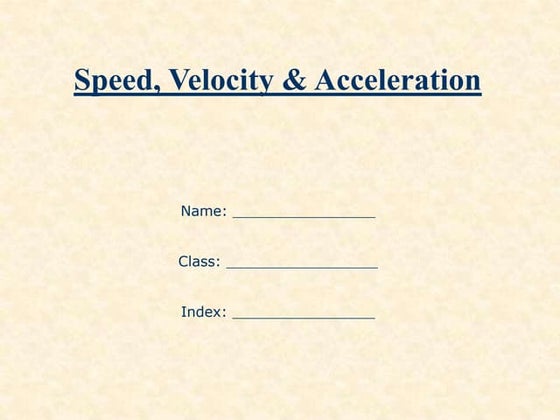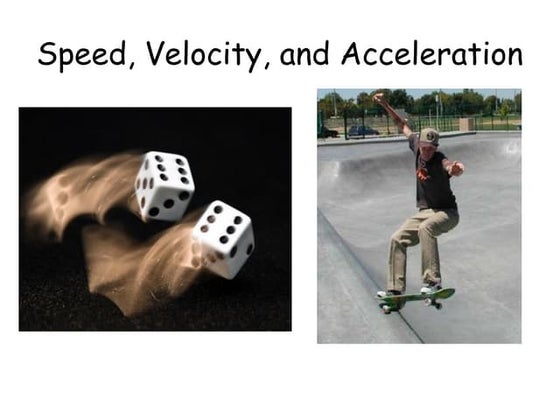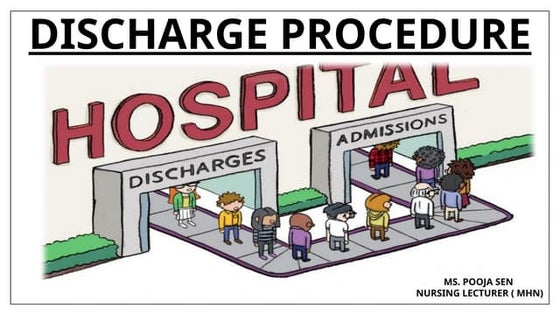kinematicsmotionalongastraightline.pptxx
- 2. Displacement VS. Distance FREE FALL Speed vs. velocity Acceleration 4 kinematic equations
- 3. KINEMATICS ’ü▒ Describes motion in terms of displacement, velocity, and acceleration. Motion ’ü▒ Is the displacement of an object in relation to objects that are considered to be stationary. ’ü▒ It can also be defined as the continuous change of position with respect to a certain reference point.
- 4. DISTANCE AND DISPLACEMENT Distance Vs. Displacement Distance is a scalar quantity that refers to "how much ground an object has covered" during its motion. Displacement is a vector quantity that refers to "how far out of place an object is"; it is the object's overall change in position. Ō¢│
- 5. THE DIRECTION OF THE DISPLACEMENT VECTOR In dealing with displacement, you need to consider its direction which represents the direction from the initial position to the final position. It is important to consider that displacement does not depend on the path taken by an object but only on its initial and final position.
- 6. THE DIRECTION OF THE DISPLACEMENT VECTOR Calculate the displacement of a car as it moves from position 1 towards position 2, Answer: Ō¢│x = xf - xi = -5 - 0 = -5 position 2 towards position 3, Answer: Ō¢│x = xf - xi = 5 - (-5) = 10 position 3 towards position 2. Answer: Ō¢│x = xf - xi = (-5) - (5) = -10
- 7. EXAMPLES Example: 1. A car travels along a straight road 100 m east then 50 m west. Find distance and displacement of the car. 2. A runner travels around rectangle track with length = 50 meters and width = 20 meters. After travels around rectangle track two times, runner back to starting point. Determine distance and displacement.
- 8. SPEED AND VELOCITY Speed Vs. Velocity Speed is a scalar quantity that refers to "how fast an object is moving." Speed can be thought of as the rate at which an object covers distance. Where d= distance t = time
- 9. SPEED AND VELOCITY Speed Vs. Velocity Velocity is a vector quantity that refers to "the rate at which an object changes its position.ŌĆ£
- 10. SPEED AND VELOCITY Example: Jefrey walks 200 m from his house to school. Upon his arrival to the gate of the school, he just realized that he needs to go to a store which is halfway from his house to buy a pen. What are his a) average speed and b) average velocity when he arrived at the store if the time it takes for the entire trip is 3 minutes?
- 13. INSTANTANEOUS SPEED AND VELOCITY
- 14. INSTANTANEOUS SPEED AND VELOCITY
- 15. INSTANTANEOUS SPEED AND VELOCITY ’ü▒ Instantaneous speed is actually the magnitude of the instantaneous velocity. Given the value of the instantaneous speed, you just add its direction then it will now become the instantaneous velocity of an object.
- 16. AVERAGE ACCELERATION ’ü▒ Average acceleration is defined as the rate of change in velocity over time. ’ü▒ An object is accelerating if the change of its velocity is in an increasing manner while an object is decelerating if the change of its velocity is in a decreasing manner.
- 17. AVERAGE ACCELERATION Accelerating motion of an object The carŌĆÖs initial velocity is 3.0 m/s. After 120s, the velocity has changed to 7.0 m/s. Calculate the average acceleration of an object during the given time interval.
- 18. AVERAGE ACCELERATION Decelerating motion of an object The carŌĆÖs initial velocity is 15.0 m/s. After 120s, the velocity has change to 2.0 m/s. Calculate the average acceleration of an object during the given time interval.
- 19. AVERAGE ACCELERATION Instantaneous Acceleration ’ü▒Acceleration of an object for a certain instant or a specific time. Figure: Instantaneous acceleration of a car
- 21. THE BIG FOUR
- 22. THE BIG FOUR Problem-Solving Strategy 1. Construct an informative diagram of the physical situation. 2. Identify and list the given information in variable form. 3. Identify and list the unknown information in variable form. 4. Identify and list the equation that will be used to determine unknown information from known information. 5. Substitute known values into the equation and use appropriate algebraic steps to solve for the unknown information. 6. Check your answer to insure that it is reasonable and mathematically correct.
- 23. THE BIG FOUR Problem-Solving Example 1: Ima Hurryin is approaching a stoplight moving with a velocity of +30.0 m/s. The light turns yellow, and Ima applies the brakes and skids to a stop. If Ima's acceleration is -8.00 m/s2 , then determine the displacement of the car during the skidding process. (Note that the direction of the velocity and the acceleration vectors are denoted by a + and a - sign.)
- 26. THE BIG FOUR Problem-Solving Example 2: Ben Rushin is waiting at a stoplight. When it finally turns green, Ben accelerated from rest at a rate of a 6.00 m/s2 for a time of 4.10 seconds. Determine the displacement of Ben's car during this time period.
- 30. THE BIG FOUR Problem-Solving Example 3: A bike accelerates uniformly from rest to a speed of 7.10 m/s over a distance of 35.4 m. Determine the acceleration of the bike.
- 34. THE BIG FOUR Problem-Solving Example 4: A car traveling at 22.4 m/s skids to a stop in 2.55 s. Determine the skidding distance of the car (assume uniform acceleration).
- 39. FREE FALL A free falling object is an object that is falling under the sole influence of gravity. Any object that is being acted upon only by the force of gravity is said to be in a state of free fall.
- 40. FREE FALL
- 41. FREE FALL
- 42. FREE FALL Important concepts to remember in Free Fall 1. An object in free fall experiences an acceleration of -9.8 m/s/s. Whether explicitly stated or not, the value of the acceleration in the kinematic equations is -9.8 m/s2 for any freely falling object. 2. If an object is merely dropped (as opposed to being thrown) from an elevated height, then the initial velocity of the object is 0 m/s. 3. If an object is projected upwards in a perfectly vertical direction, then it will slow down as it rises upward. The instant at which it reaches the peak of its trajectory, its velocity is 0 m/s. 4. If an object is projected upwards in a perfectly vertical direction, then the velocity at which it is projected is equal in magnitude and opposite in sign to the velocity that it has when it returns to the same height.
- 43. FREE FALL EXAMPLE 1: Luke Autbeloe drops a pile of roof shingles from the top of a roof located 8.52 meters above the ground. Determine the time required for the shingles to reach the ground.
- 47. FREE FALL EXAMPLE 2: Rex Things throws his mother's crystal vase vertically upwards with an initial velocity of 26.2 m/s. Determine the height to which the vase will rise above its initial height.
- 51. YOUR TURN 1. A car starts from rest and accelerates uniformly over a time of 5.21 seconds for a distance of 110 m. Determine the acceleration of the car. 2. The observation deck of tall skyscraper 370 m above the street. Determine the time required for a penny to free fall from the deck to the street below.
- 52. YOUR TURN 1. A car starts from rest and accelerates uniformly over a time of 5.21 seconds for a distance of 110 m. Determine the acceleration of the car. 2. A plane has a takeoff speed of 88.3 m/s and requires 1365 m to reach that speed. Determine the acceleration of the plane and the time required to reach this speed. 3. The observation deck of tall skyscraper 370 m above the street. Determine the time required for a penny to free fall from the deck to the street below. 4. A baseball is popped straight up into the air and has a hang-time of 6.25 s. Determine the height to which the ball rises before it reaches its peak. (Hint: the time to rise to the peak is one-half the total hang- time.)
- 53. YOUR TURN 1. A baseball is popped straight up into the air and has a hang-time of 6.25 s. Determine the height to which the ball rises before it reaches its peak. (Hint: the time to rise to the peak is one-half the total hang-time.) 2. A feather is dropped on the moon from a height of 1.40 meters. The acceleration of gravity on the moon is 1.67 m/s2 . Determine the time for the feather to fall to the surface of the moon. 3. An airplane accelerates down a runway at 3.20 m/s2 for 32.8 s until is finally lifts off the ground. Determine the distance traveled before takeoff. 4. A race car accelerates uniformly from 18.5 m/s to 46.1 m/s in 2.47 seconds. Determine the acceleration of the car and the distance traveled.
- 54. End of Session _
Editor's Notes
- #6: The negative value of displacement represents the direction of the change in position pointing towards the left of the x-axis while the positive displacement means direction pointing towards the right side of the x-axis.
- #13: The average speed of the car following a path as shown in the Figure 3B below is 5 m/s. However, at an instant time of 3 minutes during its travel, its instantaneous speed is equal to 6 m/s. The car could have different instantaneous speeds during its travel or it might have a zero instantaneous speed if it stopped for a given time.
- #39: Free-falling objects do not encounter air resistance. All free-falling objects (on Earth) accelerate downwards at a rate of 9.8 m/s/s Set example the leaning tower of Pisa
- #40: Free-falling objects do not encounter air resistance. All free-falling objects (on Earth) accelerate downwards at a rate of 9.8 m/s/s Set example the leaning tower of Pisa
- #41: Free-falling objects do not encounter air resistance. All free-falling objects (on Earth) accelerate downwards at a rate of 9.8 m/s/s Set example the leaning tower of Pisa
- #42: Free-falling objects do not encounter air resistance. All free-falling objects (on Earth) accelerate downwards at a rate of 9.8 m/s/s Set example the leaning tower of Pisa
- #43: Free-falling objects do not encounter air resistance. All free-falling objects (on Earth) accelerate downwards at a rate of 9.8 m/s/s Set example the leaning tower of Pisa
- #47: Free-falling objects do not encounter air resistance. All free-falling objects (on Earth) accelerate downwards at a rate of 9.8 m/s/s Set example the leaning tower of Pisa
- #51: Your hang time is the length of time that youŌĆÖre suspended in mid-air.
- #52: Your hang time is the length of time that youŌĆÖre suspended in mid-air.
- #53: Your hang time is the length of time that youŌĆÖre suspended in mid-air.

























































































































